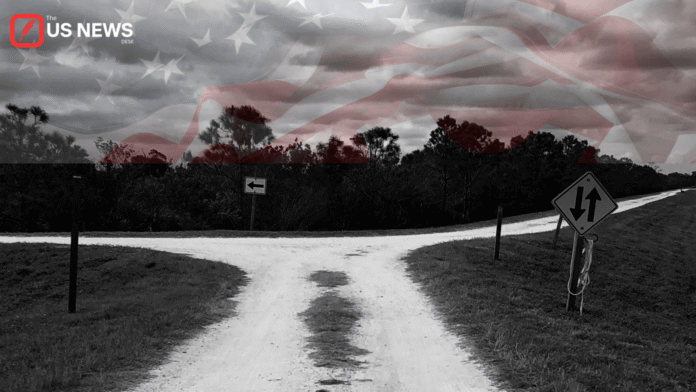This Content Is Only For Subscribers
The United States, in 2025, is not just navigating policy disputes — it is wrestling with fundamental questions about its identity, stability, and democratic resilience. As the Trump administration presses forward with its second-term agenda, Americans find themselves more divided, more anxious, and more uncertain about the nation’s future than at any time in recent memory.
From immigration crackdowns and trade disputes to concerns over inflation and institutional integrity, the story of U.S. politics today is one of contrasts: strength and fragility, optimism and disillusionment, unity and fragmentation.
Immigration: A Battlefield of Identity and Policy
Few issues ignite political passions like immigration. President Trump’s decision to expand National Guard deployments at key border entry points has become both a rallying cry for his base and a source of deep unease for immigrant communities. Supporters argue the move restores sovereignty, strengthens security, and curbs unlawful entry. Detractors see something far more troubling: an America where cultural expression feels silenced and immigrant communities live under heightened surveillance.
The consequences ripple beyond the border. In Chicago, concerns over troop mobilizations prompted the cancellation of Mexican Independence Day celebrations, a decision that symbolizes how deeply immigration enforcement policies affect civic life. What should have been a moment of cultural pride turned into an emblem of fear and caution.
This reflects a broader trend: immigration is no longer just about border crossings; it has become a proxy for national identity. For some, a secure border defines patriotism. For others, inclusivity and cultural acceptance are the essence of America. The conflict between these views is not only political but existential.
Economic Growth Meets Household Strain
The economy offers another paradox. At the macro level, corporate profits remain strong, stock indexes hover near record highs, and some sectors — especially energy and defense — are expanding. Yet beneath the surface lies widespread discontent.
- Inflation continues to squeeze household budgets, particularly for groceries, fuel, and housing.
- Wage stagnation undermines the perception of prosperity, especially among working-class and middle-income families.
- Debt levels are rising, with both consumer credit and student loans creating long-term vulnerability.
The administration points to tariff-driven policies as a pathway to revive American manufacturing. But recent indicators — including an 80% drop in postal imports after tariff shifts — show how trade policies can produce immediate disruptions, especially for small businesses reliant on global supply chains.
This dual reality — corporate success paired with family hardship — defines the current economic debate. The question is not whether the U.S. economy is “growing,” but whether ordinary Americans feel that growth in their daily lives.
Institutions Under Strain
Perhaps the most pressing crisis of all lies in the erosion of trust. America’s institutions — Congress, the judiciary, the media, and even the electoral system — face historically low confidence ratings.
- Congress remains paralyzed by partisan gridlock, often more focused on political theater than legislative solutions.
- The judiciary faces accusations of politicization, with major rulings frequently split along ideological lines.
- The media landscape, fractured along partisan lines, fuels suspicion rather than consensus.
- Elections continue to be shadowed by disputes over voting laws, ballot access, and allegations of irregularities.
This collective erosion of institutional legitimacy is dangerous. It provides fertile ground for political extremes, where both far-right and far-left movements present themselves as the only “true defenders” of America. In doing so, they weaken the center — the very foundation that has historically provided balance and stability.
The Role of Leadership
At the heart of the debate is leadership. President Trump remains a polarizing figure — celebrated by millions who view him as the voice of forgotten Americans, and equally opposed by millions who see him as a destabilizing force. His administration’s ability to command loyalty is undeniable, but it comes at the cost of intensifying division.
Meanwhile, Democrats struggle to present a unified counter-narrative. Infighting between progressive and centrist wings hampers their ability to mount an effective opposition strategy. The absence of a singular, resonant message leaves voters with skepticism: if not Trump, then who?
This vacuum of bipartisan leadership underscores why so many Americans feel politically homeless — alienated from both parties and doubtful of any institution’s capacity to represent them faithfully.
What Lies Ahead?
The political future of the United States rests on three unresolved challenges:
- Immigration Balance — Can the nation find a framework that secures borders without undermining civil liberties and cultural expression?
- Economic Equity — Can prosperity be measured not just by Wall Street’s success but by Main Street’s security?
- Restoring Trust — Can institutions rebuild credibility in a time when skepticism dominates public opinion?
The answers will not come easily. They require courage, compromise, and a return to the idea of politics as governance, not performance.
Editorial View
As editors, we cannot ignore the uncomfortable truth: America’s political crisis is not only about policy but about trust and belonging. Policies will come and go, but the erosion of faith in institutions, leaders, and one another poses the greatest long-term risk.
The United States has always thrived when it embraced both security and openness, strength and compassion, capitalism and fairness. The challenge before us is whether leaders can rise above partisanship long enough to preserve that delicate balance.
If they fail, America risks becoming a house divided not by walls or tariffs, but by mistrust.




